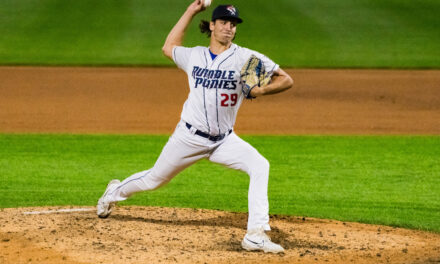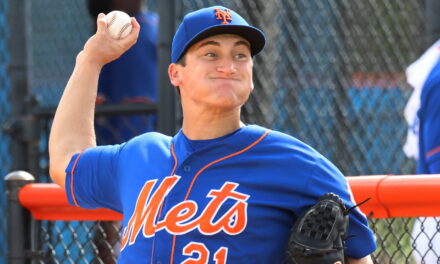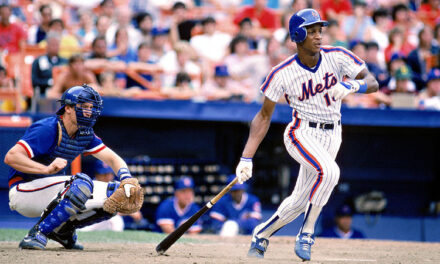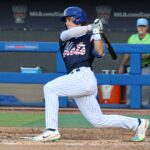Yesterday, Steve Popper of the Bergen Record was nice enough to answer a few questions for us. Steve covers the New York Mets for the Record and also has a great blog, Amazin’ Stories which I love to check out each day. Okay, here goes…
JD – Before I throw some Mets related questions at you, I’ve noticed that you have been keeping a watchful eye on the latest round of steroids hearings on your blog. It seems like most of the players, coaches, agents, and executives could learn a great deal from your 7-year old son, Colin who said, "Don’t they know that getting bigger and stronger doesn’t make you a good player? The only way to get better is to practice."
My question is this, why isn’t there more pressure put on baseball to follow an anti-doping policy like they use in the Olympics where they hold blood and urine samples indefinitely even to be tested at later times when better drug tests are discovered, especially for stimulants and HGH? Even their strict punishments are handed down swiftly and without prejudice. Despite the showmanship of late, I still have the feeling that Major League baseball still doesn’t get it.
SP: Despite what my seven-year-old son thinks, I’m still not certain what I think about the steroid issue – and I’m not sure baseball does either. I think that the primary concern of Major League Baseball right now is shielding itself from what might come next. There are still investigations going on now and with each player that comes forward and confesses, the investigators find themselves another willing witness. This could get much bigger and uglier because everything we hear is that the numbers that came out in the Mitchell Report are just the tip of the iceberg.
I think one thing that came out of the Mitchell Report was the revelation that pitchers are just as prone to juice as batters. So a part of me thinks, ‘The hitters juiced. The pitchers juiced. The parks are small. The ball is juiced. Let’s just move on.’ The dangers of steroids are there and that is another issue, but I have a hard time getting worked up on the effects of steroids on the game. And as far as the kids, like Charles Barkley once said, to paraphrase, raise your own children and don’t rely on athletes to set the example.
Okay on to some Mets questions…
JD – I guess you could say that the Mets’ most significant move this off-season so far, was the trade of Lastings Milledge to the Nationals for Brian Schneider and Ryan Church. What was your take on this trade and do you think it helped the Mets in the long and short term?
SP: I think sometimes I’m the only one that feels this way, but I am not a believer in this deal at all. I know that in the Mets’ organization there is a confidence that they got two solid pieces who are ready to help right now.
But I’m not so sure about that and I have bigger problems with the deal. First, I think it’s because I believe that Milledge is drastically undervalued in the deal. Look, we never know exactly what deals could be made until both sides agree, but Milledge was discussed in deals for Manny Ramirez a few years back, Roy Oswalt two years ago and Barry Zito last year. I think the Mets were ready to pull the trigger on Oswalt, but on the whole, they protected Milledge.
Now, they get a catcher who some people who scout him tell me has drastically declined defensively and offers nothing at the plate. In Church, they get a guy who had a solid season last year, but it took him a long time to get there.
Where might Lastings Milledge be when he’s Church’s age? I think we’re going to find out because he’s going to get a chance in Washington to play every day in centerfield and I think the Mets may live to regret this deal. Part of the decline in Milledge’s value came from his performance, which was erratic at best. But he’s still very young and raw. Centerfield is his natural position, if not the best spot for him. He may be better someday in left field, but he was a much better fielder when he filled in for Carlos Beltran in center and I think we’ll see that in Washington. And offensively, he’s still got the tools that project to a pretty good hitter.
I think that the real reason for his decline was the reputation he developed – some of it stemming from the media and some of it from teammates, who he had trouble fitting in with. I think that he was not exactly David Wright, but who is? He was a young kid who I think had troubles that were overblown and he made a legitimate effort this year to prove himself to be a more mature, less self-centered teammate. Maybe it never would have worked here and who knows if there is something we don’t know about? But I think with what we know, the Mets got the raw end of this deal. Not Scott Kazmir bad, but not good either.
JD – Many Mets fans including myself, believed that after the humiliating end to the Mets’ season, that Omar Minaya was going to attack the trade market and free agency with a vengeance. Obviously, that never happened and it looks like the Mets may very well go into 2008 with a rotation that has been weakened by the loss of Tom Glavine. What went wrong?
SP: Well, I think that reality set in. The Mets clearly went into the winter with the goal of finding themselves a front of the rotation starter – and that hasn’t changed today as they are still chasing that every day.
But the free agent market was, from the start, lacking talent and bargains. One Mets’ official scoffed at reports that had them offering four years and $40 million to Lohse. Every pitcher on the market had flaws – injuries, uncertainty — and the biggest flaw was a desperate market that had prices inflated once again.
The Mets quickly turned their focus to the trade market and again, the price tag has been off the charts. Look at what the Diamondbacks paid for Dan Haren — a wholesale selloff of their farm system — and he might still have been the best value available.
The Santana chase is still on and will be until he’s either dealt or the midseason trade deadline passes. But I’ve thought all along that the Mets could really hurt themselves with this deal. As great as Santana is – and he’s the best pitcher on the market now and maybe for years to come with teams desperately trying to keep their starters off the market — to send a reasonably even exchange to Minnesota and then have to sign him to essentially an overpriced free agent deal to complete the deal makes you pay twice. The example I use is this: You can argue that the Mets overpaid for Carlos Beltran, as solid as he has been. But now consider that before the Mets paid him $119 million, they had to send Lastings Milledge, Aaron Heilman and Carlos Gomez to the Astros. Still like the deal?
And here’s the final point I make on this: If Maine and Perez are not flash in the pans, if Pedro Martinez really is back and healthy and El Duque can survive a season, is it really so bad to entrust the fifth spot to Mike Pelfrey? I don’t think so.
* * * * * * * * * * * * * * * * * *
I will be posting the conclusion to our interview later on this afternoon as soon as I finish formatting it. Check back and see where Steve believes the Mets rank in the NL East and a few more Mets questions.













